Healing Spaces as a Design Approach to Optimize Emotional Regulation for Patients with Mood Disorders
Abstract
1. Introduction
- What spatial stimuli are associated with sensory experience and emotion regulation in patients with mood disorders?
- How do people with emotional disorders achieve emotion regulation through healing spaces?
2. Healing Spaces Designed to Optimize Health, Well-Being and Recovery
2.1. Healing Framework of Space
2.2. Healing Structure of Space
3. Healing Spaces for Emotional Regulation
3.1. Space Regulates Emotions through Sensory Stimulation
3.2. Spatial Elements Create Emotional Atmospheres
4. Findings
5. Discussion
6. Conclusions
- An analysis of the process through which healing spaces facilitate emotional regulation (refer to Figure 8);
- A summary of the relationship between sensory factors, spatial stimulus elements, therapeutic structures, and emotional climate (refer to Figure 10);
- A conclusion that presents a model illustrating how healing spaces impact emotional regulation (refer to Figure 11).
7. Future Vision
Author Contributions
Funding
Data Availability Statement
Conflicts of Interest
References
- Engineer, A.; Ida, A.; MSternberg, E. Healing spaces: Designing physical environments to optimize health, wellbeing, and performance. Int. J. Environ. Res. Public Health 2020, 17, 1155. [Google Scholar] [CrossRef] [PubMed]
- DuBose, J.; MacAllister, L.; Hadi, K.; Sakallaris, B. Exploring the concept of healing spaces. HERD Health Environ. Res. Des. J. 2018, 11, 43–56. [Google Scholar] [CrossRef] [PubMed]
- Bell, S.L.; Foley, R.; Houghton, F.; Maddrell, A.; Williams, A.M. From therapeutic landscapes to healthy spaces, places and practices: A scoping review. Soc. Sci. Med. 2018, 196, 123–130. [Google Scholar] [CrossRef] [PubMed]
- Bower, I.; Tucker, R.; Enticott, P.G. Impact of built environment design on emotion measured via neurophysiological correlates and subjective indicators: A systematic review. J. Environ. Psychol. 2019, 66, 101344. [Google Scholar] [CrossRef]
- Essa, S.S.; Jabbari, A.N.A. The impact of Salutogenic factors on the process of patient’s recovery Case study; Erbil city hospitals. Anbar J. Eng. Sci. 2020, 8, 228–251. [Google Scholar] [CrossRef]
- Allahyar, M.; Kazemi, F. Effect of landscape design elements on promoting neuropsychological health of children. Urban For. Urban Green 2021, 65, 127333. [Google Scholar] [CrossRef]
- Aristizabal, S.; Byun, K.; Porter, P.; Clements, N.; Campanella, C.; Li, L.; Mullan, A.; Ly, S.; Senerat, A.; Nenadic, I.Z.; et al. Biophilic office design: Exploring the impact of a multisensory approach on human well-being. J. Environ. Psychol. 2021, 77, 101682. [Google Scholar] [CrossRef]
- Yao, W.; Zhang, X.; Gong, Q. The effect of exposure to the natural environment on stress reduction: A meta-analysis. Urban For. Urban Green. 2021, 57, 126932. [Google Scholar] [CrossRef]
- Ulrich, R.S.; Simons, R.F.; Losito, B.D.; Fiorito, E.; Miles, M.A.; Zelson, M. Stress recovery during exposure to natural and urban environments. J. Environ. Psychol. 1991, 11, 201–230. [Google Scholar] [CrossRef]
- Djimantoro, M.I. Multisensory experience for mental health in higher education classroom design. In IOP Conference Series: Earth and Environmental Science; IOP Publishing: Bristol, UK, 2018; Volume 195, p. 012081. [Google Scholar]
- Kessler, R.C.; Petukhova, M.; Sampson, N.A.; Zaslavsky, A.M.; Wittchen, H.U. Twelve-month and lifetime prevalence and lifetime morbid risk of anxiety and mood disorders in the United States. Int. J. Methods Psychiatr. Res. 2012, 21, 169–184. [Google Scholar] [CrossRef] [PubMed]
- Lee, Y.-C.; Chen, V.C.-H.; Yang, Y.-H.; Kuo, T.-Y.; Hung, T.-H.; Cheng, Y.-F.; Huang, K.-Y. Association between emotional disorders and speech and language impairments: A national population-based study. Child Psychiatry Hum. Dev. 2020, 51, 355–365. [Google Scholar] [CrossRef]
- Gross, J.J.; John, O.P. Individual differences in two emotion regulation processes: Implications for affect, relationships, and well-being. J. Pers. Soc. Psychol. 2003, 85, 348. [Google Scholar] [CrossRef]
- Carl, E.; Witcraft, S.M.; Kauffman, B.Y.; Gillespie, E.M.; Becker, E.S.; Cuijpers, P.; Van Ameringen, M.; Smits, J.A.J.; Powers, M.B. Psychological and pharmacological treatments for generalized anxiety disorder (GAD): A meta-analysis of randomized controlled trials. Cogn. Behav. Ther. 2020, 49, 1–21. [Google Scholar] [CrossRef]
- Rodriguez, M.; Kross, E. Sensory emotion regulation. Trends Cogn. Sci. 2023, 27, 379–390. [Google Scholar] [CrossRef] [PubMed]
- Reddy, S.M.; Chakrabarti, D.; Karmakar, S. Emotion and interior space design: An ergonomic perspective. Work 2012, 41 (Suppl. S1), 1072–1078. [Google Scholar] [CrossRef] [PubMed]
- Sivak, K. Implementation of comfort rooms to reduce seclusion, restraint use, and acting-out behaviors. J. Psychosoc. Nurs. Ment. Health Serv. 2012, 50, 24–34. [Google Scholar] [CrossRef] [PubMed]
- Björkdahl, A.; Perseius, K.I.; Samuelsson, M.; Lindberg, M.H. Sensory rooms in psychiatric inpatient care: Staff experiences. Int. J. Ment. Health Nurs. 2016, 25, 472–479. [Google Scholar] [CrossRef] [PubMed]
- Jonas, W.B.; Chez, R.A.; Smith, K.; Sakallaris, B. Salutogenesis: The defining concept for a new healthcare system. Glob. Adv. Health Med. 2014, 3, 82–91. [Google Scholar] [CrossRef] [PubMed]
- Sakallaris, B.R.; Macallister, L.; Voss, M.; Smith, K.; Jonas, W.B. Optimal healing environments. Glob. Adv. Health Med. 2015, 4, 40–45. [Google Scholar] [CrossRef] [PubMed]
- Marpuah, S.; Pribadi, O.S. Penerapan Konsep Healing Environment di Ruang Rehabilitasi Medik dan Healing Garden pada Rumah Sakit Orthopedi. In Prosiding Seminar Intelektual Muda; 2019; Volume 1, Available online: https://www.e-journal.trisakti.ac.id/index.php/sim/article/view/5768 (accessed on 3 February 2024).
- Zhang, Y.; Tzortzopoulos, P.; Kagioglou, M. Healing built-environment effects on health outcomes: Environment–occupant–health framework. Build. Res. Inf. 2019, 47, 747–766. [Google Scholar] [CrossRef]
- Cho, M. Evaluating Therapeutic Healthcare Environmental Criteria: Architectural Designers’ Perspectives. Int. J. Environ. Res. Public Health 2023, 20, 1540. [Google Scholar] [CrossRef] [PubMed]
- Younis, G.M. Design Strategies for Healing Internal Environments and Workplaces A Theoretical Framework. J. Sustain. Arch. Civ. Eng. 2021, 29, 33–48. [Google Scholar] [CrossRef]
- Wallmann-Sperlich, B.; Hoffmann, S.; Salditt, A.; Bipp, T.; Froboese, I. Moving to an “Active” biophilic designed office workplace: A pilot study about the effects on sitting time and sitting habits of office-based workers. Int. J. Environ. Res. Public Health 2019, 16, 1559. [Google Scholar] [CrossRef] [PubMed]
- Taheri, S.; Sichani, M.G. The role of interior architecture in the spaces of rehabilitation, especial for children with a focus on evidences-based design approach. Int. J. Humanit. Cult. Stud. 2015, 2, 1758–1767. [Google Scholar]
- Mahmood, F.J.; Tayib, A.Y. The role of patients’ psychological comfort in optimizing indoor healing environments: A case study of the indoor environments of recently built hospitals in Sulaimani City, Kurdistan, Iraq. HERD Health Environ. Res. Des. J. 2020, 13, 68–82. [Google Scholar] [CrossRef] [PubMed]
- Cramer, J.S.; Browning, W.D. Transforming building practices through biophilic design. In Biophilic Design; Wiley: Hoboken, NJ, USA, 2008; Volume 335, p. 346. [Google Scholar]
- Ryan, C.O.; Browning, W.D.; Clancy, J.O.; Andrews, S.L.; Kallianpurkar, N.B. Biophilic design patterns: Emerging nature-based parameters for health and well-being in the built environment. ArchNet-IJAR Int. J. Arch. Res. 2014, 8, 62. [Google Scholar] [CrossRef]
- Simonsen, T.P.; Duff, C. Healing architecture and psychiatric practice:(re) ordering work and space in an in-patient ward in Denmark. Sociol. Health Illn. 2020, 42, 379–392. [Google Scholar] [CrossRef] [PubMed]
- McLaughlan, R. Psychosocially supportive design: The case for greater attention to social space within the pediatric hospital. HERD Health Environ. Res. Des. J. 2018, 11, 151–162. [Google Scholar] [CrossRef]
- Borowczyk, J. Rehabilitation Spaces–Architecture for Children with Multiple Disabilities. In IOP Conference Series: Materials Science and Engineering; IOP Publishing: Bristol, UK, 2019; Volume 471, p. 072017. [Google Scholar]
- Singh, S.; Sabahat, M.; Qamrudiin, J. The Impact of Architecture in the Process of Healing & Well-Being. Int. J. Res. Appl. Sci. Eng. Technol. 2021, 9, 1–23. [Google Scholar]
- MacAllister, L.; Bellanti, D.; Sakallaris, B.R. Exploring inpatients’ experiences of healing and healing spaces: A mixed methods study. J. Patient Exp. 2016, 3, 119–130. [Google Scholar] [CrossRef]
- Miller, W.L.; Crabtree, B.F. Healing landscapes: Patients, relationships, and creating optimal healing places. J. Altern. Complement. Med. 2005, 11 (Suppl. S1), s-41–s-49. [Google Scholar] [CrossRef]
- Bray, I.; Reece, R.; Sinnett, D.; Martin, F.; Hayward, R. Exploring the role of exposure to green and blue spaces in preventing anxiety and depression among young people aged 14–24 years living in urban settings: A systematic review and conceptual framework. Environ. Res. 2022, 214, 114081. [Google Scholar] [CrossRef]
- Dobkin, P.L. Healing spaces in medicine. Int. J. Whole Pers. Care 2023, 10, 1–2. [Google Scholar] [CrossRef]
- Junardi, N.N.; Leonardo, V.A. Pendekatan Green Design Dalam Perancangan Healing Space. In SENADA (Seminar Nasional Manajemen, Desain Dan Aplikasi Bisnis Teknologi); 2023; Volume 6, pp. 76–87. Available online: https://eprosiding.idbbali.ac.id/index.php/senada/article/view/740 (accessed on 3 February 2024).
- Higuera-Trujillo, J.L.; Llinares, C.; Macagno, E. The cognitive-emotional design and study of architectural space: A scoping review of neuroarchitecture and its precursor approaches. Sensors 2021, 21, 2193. [Google Scholar] [CrossRef]
- Tuszynska-Bogucka, W.; Kwiatkowski, B.; Chmielewska, M.; Dzieńkowski, M.; Kocki, W.; Pełka, J.; Przesmycka, N.; Bogucki, J.; Galkowski, D. The effects of interior design on wellness–Eye tracking analysis in determining emotional experience of architectural space. A survey on a group of volunteers from the Lublin Region, Eastern Poland. Ann. Agric. Environ. Med. 2020, 27, 113–122. [Google Scholar] [CrossRef]
- Abusaada, H. Strengthening the affectivity of atmospheres in urban environments: The toolkit of multi-sensory experience. Archnet-IJAR Int. J. Arch. Res. 2020, 14, 379–392. [Google Scholar] [CrossRef]
- Stoffregen, T.A.; Mantel, B.; Bardy, B.G. The senses considered as one perceptual system. Ecol. Psychol. 2017, 29, 165–197. [Google Scholar] [CrossRef]
- Turgay, Z.T.; Sarıberberoğlu, M.T. The Role of the Senses in Children’s Perception of Space. ICONARP Int. J. Arch. Plan. 2022, 10, 70–96. [Google Scholar]
- Canbeyli, R. Sensory stimulation via the visual, auditory, olfactory and gustatory systems can modulate mood and depression. Eur. J. Neurosci. 2022, 55, 244–263. [Google Scholar] [CrossRef] [PubMed]
- Geipel, J.; Koenig, J.; Hillecke, T.K.; Resch, F. Short-term music therapy treatment for adolescents with depression—A pilot study. Arts Psychother. 2022, 77, 101874. [Google Scholar] [CrossRef]
- Lundqvist, L.O.; Carlsson, F.; Hilmersson, P.; Juslin, P.N. Emotional responses to music: Experience, expression, and physiology. Psychol. Music 2009, 37, 61–90. [Google Scholar] [CrossRef]
- Ballantyne, K.C. Noise aversion. Behav. Probl. Dog. Cat-E-Book 2023, 123–126. [Google Scholar]
- Igarashi, M.; Song, C.; Ikei, H.; Ohira, T.; Miyazaki, Y. Effect of olfactory stimulation by fresh rose flowers on autonomic nervous activity. J. Altern. Complement. Med. 2014, 20, 727–731. [Google Scholar] [CrossRef] [PubMed]
- Porcherot, C.; Delplanque, S.; Raviot-Derrien, S.; Le Calvé, B.; Chrea, C.; Gaudreau, N.; Cayeux, I. How do you feel when you smell this? Optimization of a verbal measurement of odor-elicited emotions. Food Qual. Prefer. 2010, 21, 938–947. [Google Scholar] [CrossRef]
- Eckstein, M.; Mamaev, I.; Ditzen, B.; Sailer, U. Calming effects of touch in human, animal, and robotic interaction—Scientific state-of-the-art and technical advances. Front. Psychiatry 2020, 11, 555058. [Google Scholar] [CrossRef] [PubMed]
- Vinson, J. Weighted blankets: Anxiety reduction in adult patients receiving chemotherapy. Clin. J. Oncol. Nurs. 2020, 24, 360–368. [Google Scholar] [CrossRef] [PubMed]
- MacLean, K.E. Putting haptics into the ambience. IEEE Trans. Haptics 2009, 2, 123–135. [Google Scholar] [CrossRef] [PubMed]
- Hedlund Lindberg, M.; Samuelsson, M.; Perseius, K.I.; Björkdahl, A. The experiences of patients in using sensory rooms in psychiatric inpatient care. Int. J. Ment. Health Nurs. 2019, 28, 930–939. [Google Scholar] [CrossRef]
- Ilioudi, M.; Lindner, P.; Ali, L.; Wallström, S.; Thunström, A.O.; Ioannou, M.; Anving, N.; Johansson, V.; Hamilton, W.; Falk, Ö.; et al. Physical Versus Virtual Reality–Based Calm Rooms for Psychiatric Inpatients: Quasi-Randomized Trial. J. Med. Internet Res. 2023, 25, e42365. [Google Scholar] [CrossRef]
- Golden, R.N.; Gaynes, B.N.; Ekstrom, R.D.; Hamer, R.M.; Jacobsen, F.M.; Suppes, T.; Wisner, K.L.; Nemeroff, C.B. The efficacy of light therapy in the treatment of mood disorders: A review and meta-analysis of the evidence. Am. J. Psychiatry 2005, 162, 656–662. [Google Scholar] [CrossRef]
- Asfour, K.S. Healing architecture: A spatial experience praxis. Archnet-IJAR Int. J. Arch. Res. 2020, 14, 133–147. [Google Scholar] [CrossRef]
- Kellert, S.R.; Heerwagen, J.; Mador, M. Biophilic Design: The Theory, Science and Practice of Bringing Buildings to Life; John Wiley & Sons: Hoboken, NJ, USA, 2011. [Google Scholar]
- Gillis, K.; Gatersleben, B. A review of psychological literature on the health and wellbeing benefits of biophilic design. Buildings 2015, 5, 948–963. [Google Scholar] [CrossRef]
- Huisman, E.; Morales, E.; van Hoof, J.; Kort, H.S.M. Healing environments: A systematic review. Build. Environ. 2012, 58, 70–80. [Google Scholar] [CrossRef]
- Buttazzoni, A.; Dean, J.; Minaker, L. Urban design and adolescent mental health: A qualitative examination of adolescent emotional responses to pedestrian-and transit-oriented design and cognitive architecture concepts. Health Place 2022, 76, 102825. [Google Scholar] [CrossRef] [PubMed]
- Spence, C. Temperature-based crossmodal correspondences: Causes and consequences. Multisensory Res. 2020, 33, 645–682. [Google Scholar] [CrossRef] [PubMed]
- Grinde, B.; Patil, G.G. Biophilia: Does visual contact with nature impact on health and well-being? Int. J. Environ. Res. Public Health 2009, 6, 2332–2343. [Google Scholar] [CrossRef]
- Annerstedt, M.; Jönsson, P.; Wallergård, M.; Johansson, G.; Karlson, B.; Grahn, P.; Hansen, Å.M.; Währborg, P. Inducing physiological stress recovery with sounds of nature in a virtual reality forest—Results from a pilot study. Physiol. Behav. 2013, 118, 240–250. [Google Scholar] [CrossRef]
- Tonetti, A.; Rossetti, M. Wood Snoezelen. Multisensory Wooden Environments for the Care and Rehabilitation of People with Severe and Very Severe Cognitive Disabilities. In International Conference on Technological Imagination in the Green and Digital Transition; Springer International Publishing: Cham, Switzerland, 2022; pp. 1003–1015. [Google Scholar]
- Li, Z.; Zhang, W.; Wang, L.; Liu, H.; Liu, H. Regulating effects of the biophilic environment with strawberry plants on psychophysiological health and cognitive performance in small spaces. Build. Environ. 2022, 212, 108801. [Google Scholar] [CrossRef]
- Yin, J.; Zhu, S.; MacNaughton, P.; Allen, J.G.; Spengler, J.D. Physiological and cognitive performance of exposure to biophilic indoor environment. Build. Environ. 2018, 132, 255–262. [Google Scholar] [CrossRef]
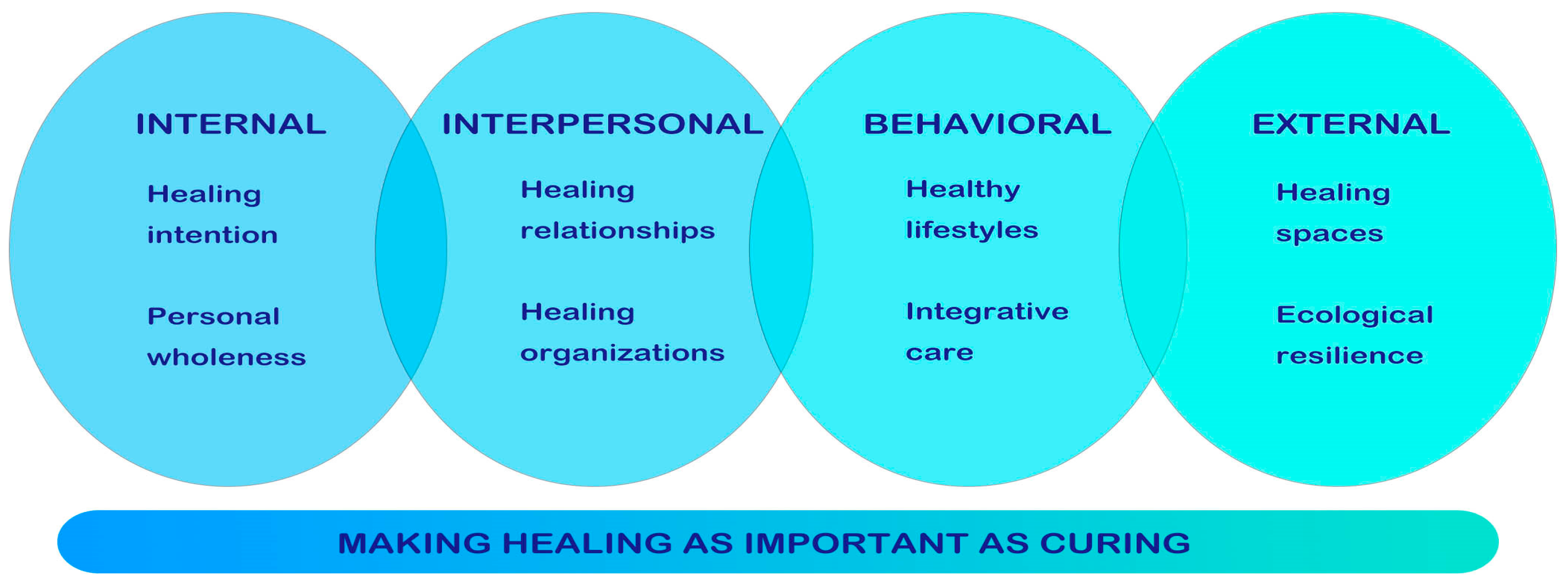
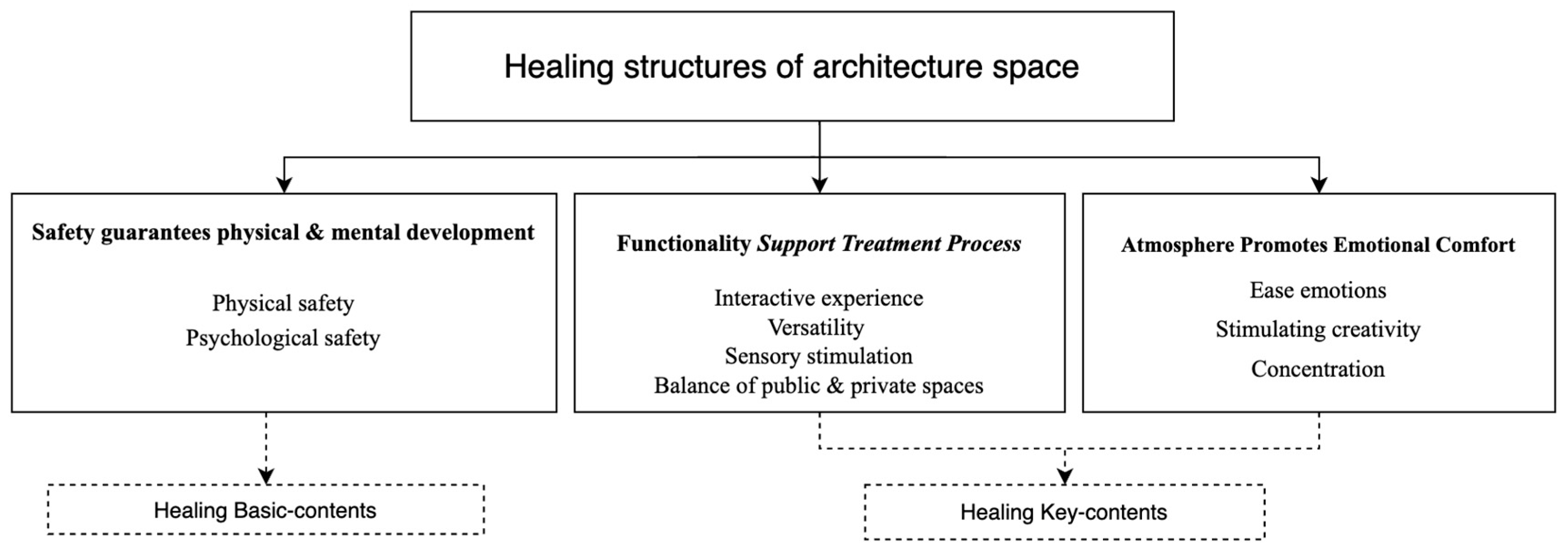
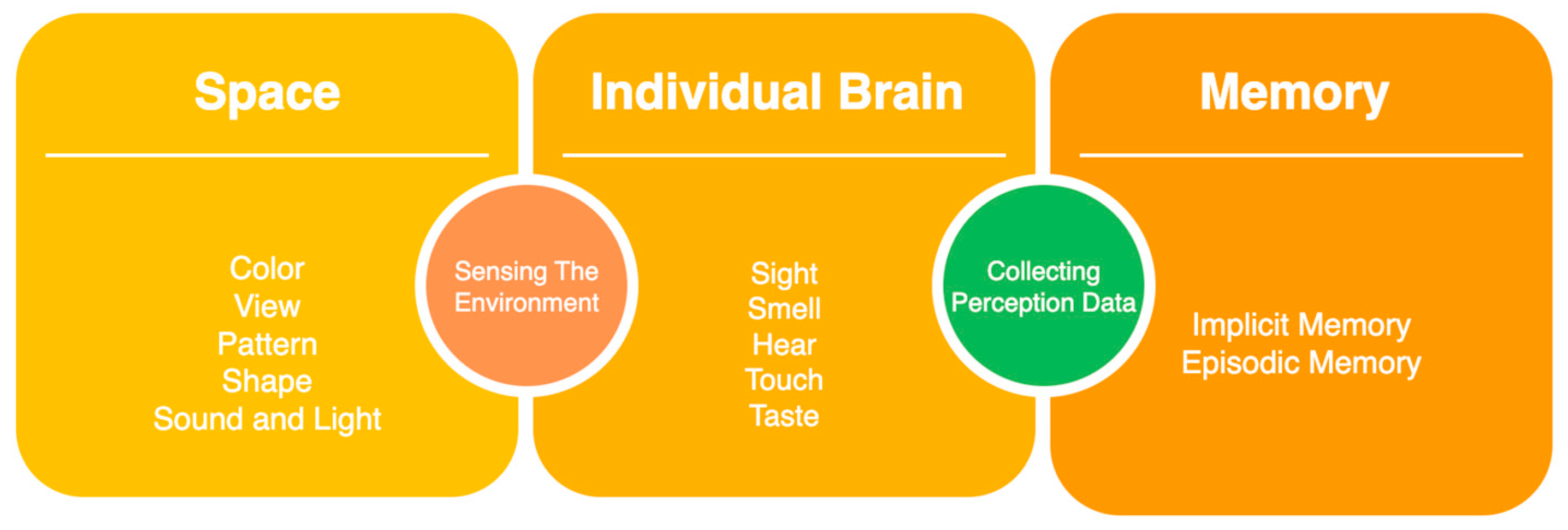
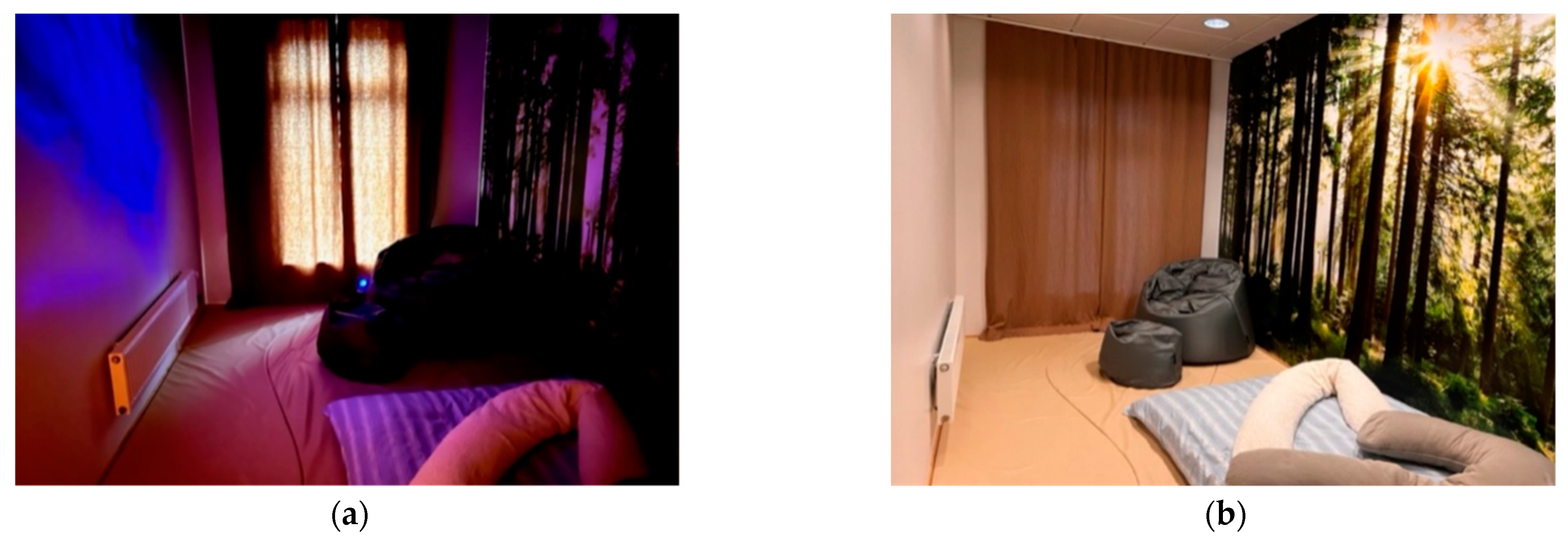
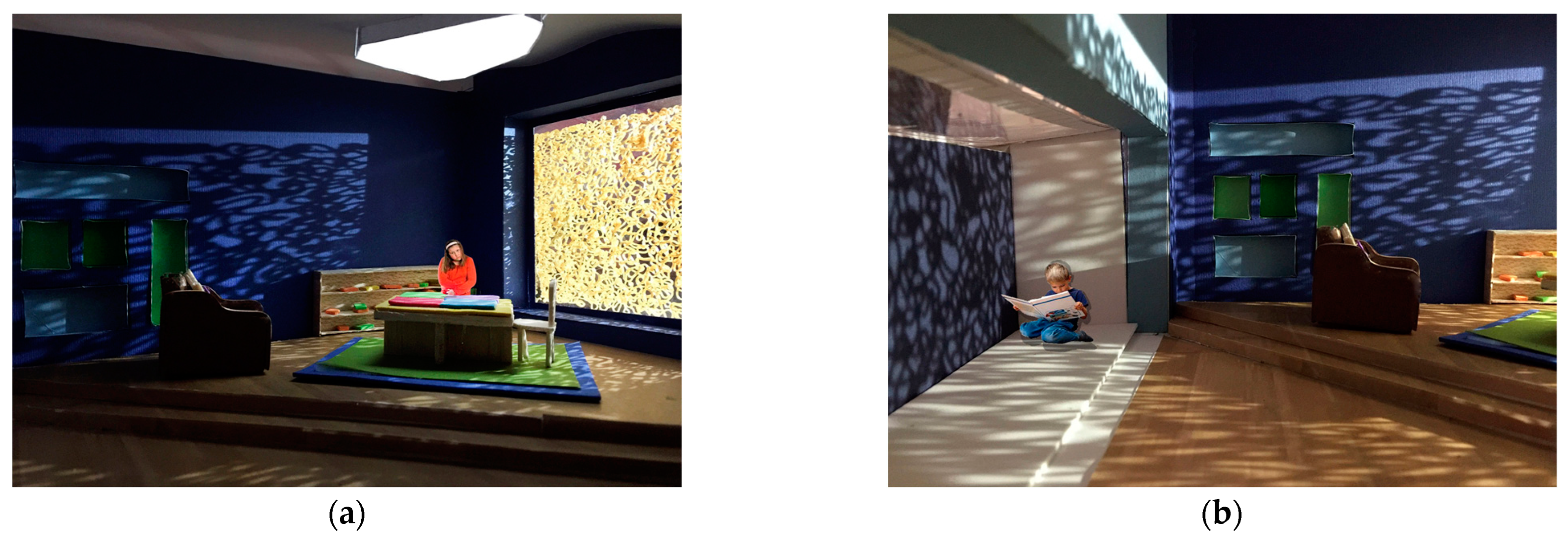
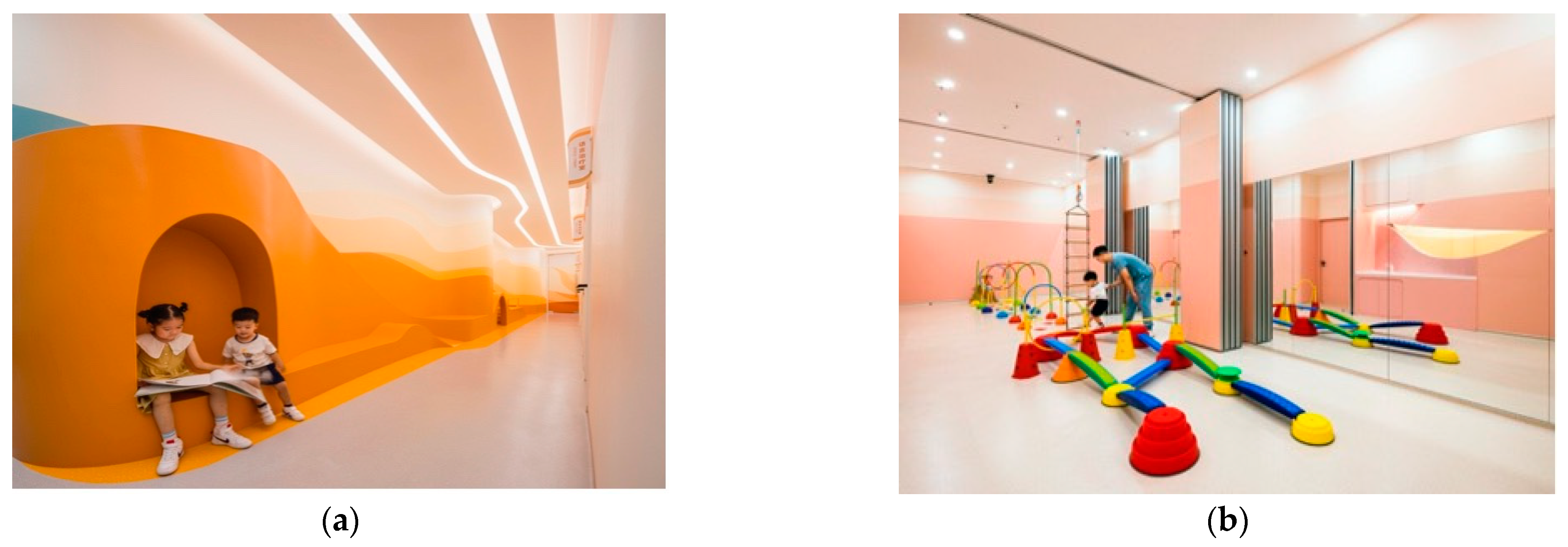
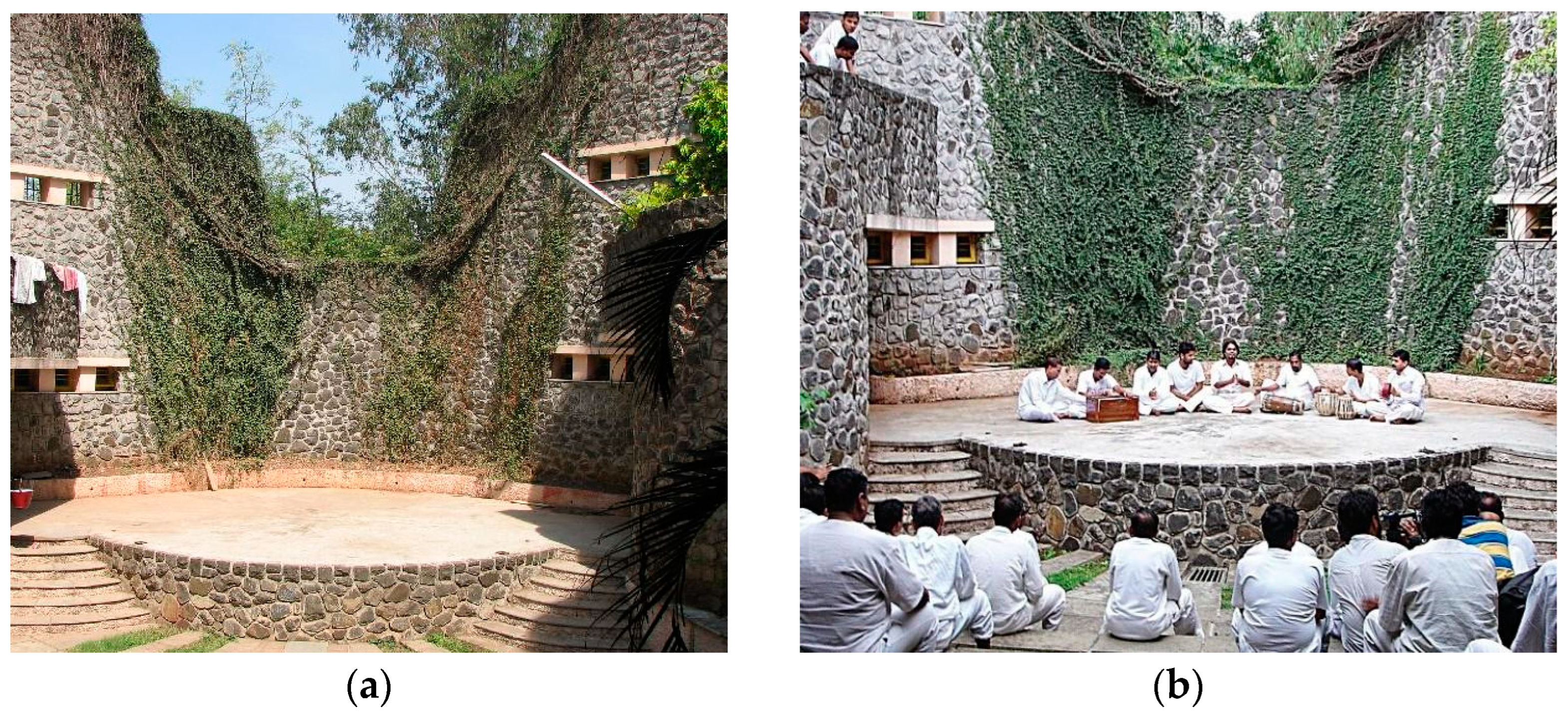
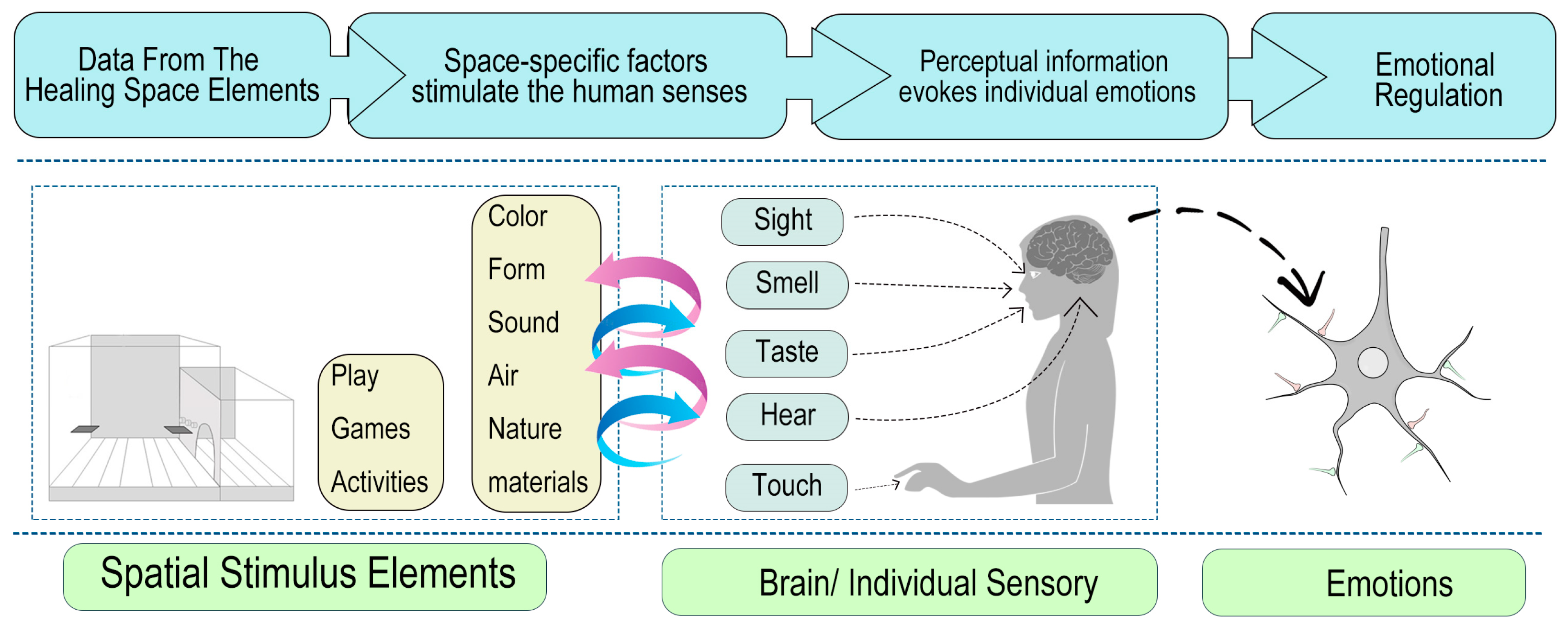


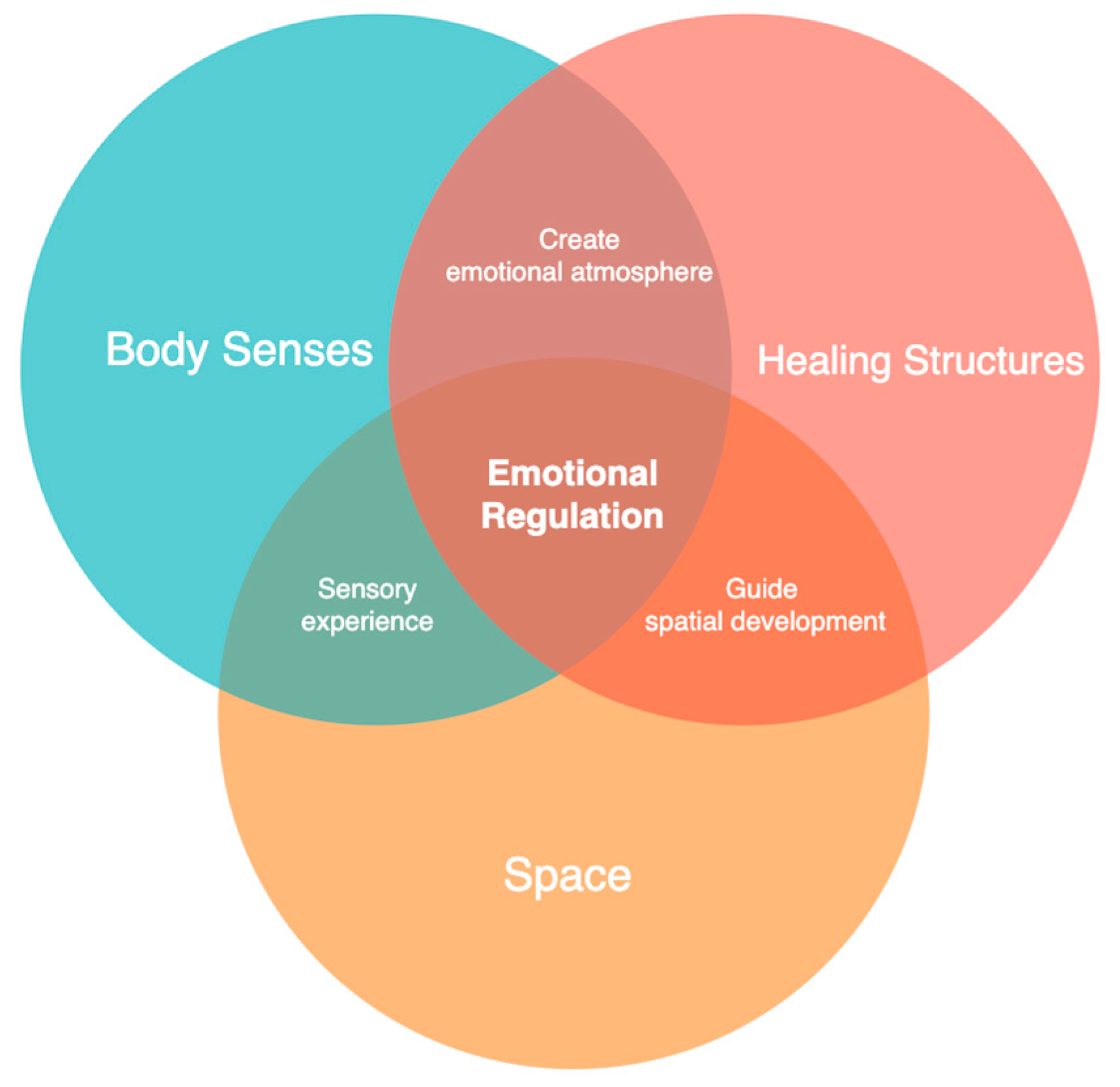
| Design Principle | Parameter | Sub-Design Parameter | |
|---|---|---|---|
| Healing built-environment (HBE) characteristics | Comfortable Environment | Light | Daylight, Electrical light, Control |
| Sound | Material, Noise, Isolation | ||
| Heat | Temperature, Control | ||
| Air quality | Ventilation, Air-filtering system | ||
| Well-functioning Space | FF&E (furniture, fixtures, equipment) | Surface, Water supply, Ergonomics | |
| Flexibility | Size, Patient room, Acuity-adaptable room, Nursing station, Family zone, Seating, Staff zone | ||
| Patient-centered care | Beds per room, Facility control, Social support | ||
| Relaxing Atmosphere | Display | Signage, Color, Art | |
| Links to nature | Indoor greenery, Window view, Garden | ||
| Multi effect | Music, Odours |
| Basic Strategy | Sub-Strategies | Specific Parameters Affected | |
|---|---|---|---|
| Design strategies | Support Strategy | Physical support | Space character, Space components character, Relationship of a space character |
| Vital support (life-energy) | Harmony with nature, Aspects of natural metaphors, Living wall | ||
| Psychological support | Phenomenal impressions, Prevent implicit passive feelings, Sensitive responses, Change of character | ||
| Balance Strategy | The balance of life components | Balance of basic components lifestyle | |
| Balance of dynamic life experience | Lifestyle, Space impression | ||
| Balances and components of the environment | Nature and quality of the environment | ||
| Nourishment Strategy | Soul nourishment-Life factor nourishment | Genius loci, Renovation meaning derived from the cosmic renewal of nature, Orientation and the biological clock | |
| Emotional nourishment | Brightness of daylight, Brightness of color, Nature elements |
| Spatial Elements | Sub-Elements | Available Frameworks Support |
|---|---|---|
| Color and Form | Blue and green space | [22,24,26,28,29] |
| Geometric shapes/Patterns | [22,24,26,28,29] | |
| Light | Daylight | [2,22,28,29] |
| Electric light | [22,26,27] | |
| Sound | Music | [22,24] |
| Quiet instead of noise | [2,22,27] | |
| Air and Temperature | Ventilation | [22,24,27] |
| Aromatic odors | [24,27,28,29] | |
| Room and object temperature | [22,24] | |
| Natural Elements | Plants | [2,22,24,27,28,29] |
| Natural Light | [2,26,28,29] | |
| Natural sound effects | [22,28,29] | |
| Natural odors | [28,29] | |
| Materials | Materiality | [22,24] |
| Texture | [24] | |
| Touch of different materials | [27,28,29] | |
| Play and Games | [26] | |
| Activities and Communication | [24,27] |
| Spatial Stimulus Elements | ||||||||
|---|---|---|---|---|---|---|---|---|
| Color and Form | Light | Sound | Air and Temperature | Natural Elements | Materials | Play and Games | Activities and Communication | |
| Sensory room from a psychiatric hospital | * | * | * | * | ||||
| PTSD Healing Space | * | * | * | * | * | * | * | |
| FlySolo Rehabilitation Medical Centre | * | * | * | * | * | * | * | |
| Muktangan Mitra Drug Rehabilitation Center | * | * | * | * | * | * | * | |
| Healing Parameters | Sub-Parameters | Positive Correlation with Patient Emotional Health | |
|---|---|---|---|
| Healing structure of space | Safety guarantees physical and mental development | Physical safety | Patients are guaranteed to be physically safe from harm. |
| Psychological safety | Respecting individual rights and emotional needs mitigates fear and anxiety. | ||
| Functionality Supports Treatment Process | Interactive experience | The space is easy to interact and experience with facilities and equipment that meet the patient’s treatment needs. | |
| Versatility | The space serves various functions to accommodate diverse therapeutic approaches. | ||
| Sensory stimulation | Sensory stimulation and calming elements are incorporated to support the patient’s therapeutic process. | ||
| Balance of public and private spaces | Treatment areas are designated for individual privacy, while also fostering opportunities for interaction and communication with other patients or staff, promoting mutual support and sharing. | ||
| Ambiance Promotes Emotional Comfort | Emotional Relief | Creating a serene ambiance contributes to relaxation, alleviating stress and anxiety. | |
| Stimulating creativity | Infusing the environment with movement, vitality, and creativity stimulates patients’ creative energy and vitality. | ||
| Concentration | Fostering inner peace and concentration, the environment promotes a calm atmosphere that enhances focus and concentration. | ||
| Biophilic Interventions Optimize Experience | Pro-natural application | Direct introduction of natural elements and natural materials to increase the tactile and visual sensation of nature. | |
| Pro-natural convergence | Indirect introduction of natural elements and nature-like patterns as well as imitation of nature’s textures and shapes to create a sense of order in the space similar to that of nature. | ||
| Pro-natural simulation | Simulation of natural environments to create landscape vistas in indoor spaces so that patients can enjoy the natural beauty of the outdoors while indoors. |
Disclaimer/Publisher’s Note: The statements, opinions and data contained in all publications are solely those of the individual author(s) and contributor(s) and not of MDPI and/or the editor(s). MDPI and/or the editor(s) disclaim responsibility for any injury to people or property resulting from any ideas, methods, instructions or products referred to in the content. |
© 2024 by the authors. Licensee MDPI, Basel, Switzerland. This article is an open access article distributed under the terms and conditions of the Creative Commons Attribution (CC BY) license (https://creativecommons.org/licenses/by/4.0/).
Share and Cite
Yan, S.; Azmi, A.; Mansor, N.; Wang, Z.; Wang, Y. Healing Spaces as a Design Approach to Optimize Emotional Regulation for Patients with Mood Disorders. Buildings 2024, 14, 472. https://doi.org/10.3390/buildings14020472
Yan S, Azmi A, Mansor N, Wang Z, Wang Y. Healing Spaces as a Design Approach to Optimize Emotional Regulation for Patients with Mood Disorders. Buildings. 2024; 14(2):472. https://doi.org/10.3390/buildings14020472
Chicago/Turabian StyleYan, Shuaijie, Athira Azmi, Noranita Mansor, Zhihao Wang, and Yike Wang. 2024. "Healing Spaces as a Design Approach to Optimize Emotional Regulation for Patients with Mood Disorders" Buildings 14, no. 2: 472. https://doi.org/10.3390/buildings14020472
APA StyleYan, S., Azmi, A., Mansor, N., Wang, Z., & Wang, Y. (2024). Healing Spaces as a Design Approach to Optimize Emotional Regulation for Patients with Mood Disorders. Buildings, 14(2), 472. https://doi.org/10.3390/buildings14020472






